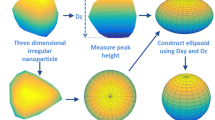Abstract
Purpose. The purpose of this work was to image crystalline drug nanoparticles from a liquid dispersion and in a solid dosage form for the determination of size, shape, and distribution.
Methods. Crystalline drug nanoparticles were adsorbed from a colloidal dispersion on glass for atomic force microscopy (AFM) imaging. Nanoparticles that were spray coated onto a host bead were exposed by ultramicrotomy for scanning electron microscopy and AFM examination.
Results. The adsorbed drug nanoparticles were measured by AFM to have a mean diameter of 95 nm and an average aspect ratio of 1.3. Nanoparticles observed in the solid dosage form had a size and shape similar to drug nanoparticles in the dispersion. Particle size distribution from AFM measurement agreed well with data from field emission scanning electron microscopy, static light scattering, and X-ray powder diffraction.
Conclusions. AFM is demonstrated to be a valuable tool in visualization and quantification of drug nanoparticle crystals in formulations. In addition to accurate size measurement, AFM readily provides shape and structural information of nanoparticles, which cannot be obtained by light scattering. Ultramicrotomy is a good sample preparation method to expose the interior of solid dosage forms with minimal structural alteration for microscopic examination.
Similar content being viewed by others
REFERENCES
R. H. Muller, C. Jacobs, and O. Kayser. Nanosuspensions as particulate drug formulations in therapy rationale for development and what we can expect for the future. Adv. Drug Deliv. Rev. 47:3-19 (2001).
G. C. Liversidge and P. Conzentino. Drug particle size reduction for decreasing gastric irritancy and enhancing absorption of naproxen in rats. Int. J. Pharm. 125:309-313 (1995).
G. C. Liversidge and K. C. Cundy. Particle size reduction for improvement of oral bioavailability of hydrophobic drugs. I. Absolute oral bioavailability of nanocrystalline danazole in beagle dogs. Int. J. Pharm. 127:309-313 (1995).
G. Binnig and H. Rohrer. Scanning tunneling microscopy. Helv. Phys. Acta 55:726-735 (1982).
G. Binnig and C. Quate. Atomic force microscope. Phys. Rev. Lett. 56:930-933 (1986).
A. Danesh, X. Chen, M. C. Davies, C. J. Roberts, G. H. W. Sanders, S. J. B. Tendlers, and P. M. Williams. Polymorphic discrimination using atomic force microscopy: distinguishing between two polymorphs of the drug cimetidine. Langmuir 16:866-870 (2000).
A. Danesh, X. Chen, M. C. Davies, C. J. Roberts, G. H. W. Sanders, S. J. B. Tendlers, P M. Williams, and M. J. Wilkins. The discrimination of drug polymorphic forms from single crystals using atomic force microscopy. Pharm. Res. 17:887-890 (2000).
A. Danesh, S. D. Cornnell, M. C. Davies, C. J. Roberts, S. J. B. Tendlers, P. M. Williams, and M. J. Wilkins. An in situ dissolution study of aspirin crystal planes (100) and (001) by atomic force microscopy. Pharm. Res. 18:299-303 (2001).
M. D. Louey, P. Mulvaney, and P. J. Stewart. Characterization of adhesional properties of lactose carriers using atomic force microscopy. J. Pharm. Biomed. Anal. 25:559-567 (2001).
U. Sindel and J. Zimmermann. Measurement of interaction forces between individual powder particles using an atomic force microscope. Powder Technol. 117:247-254 (2001).
T. H. Ibrahim, T. R. Burk, F. M. Etzler, and R. D. Neuman. Direct adhesion measurements of pharmaceutical particles to gelatin capsule surfaces. J. Adhesion Sci. Technol. 14:1225-1242 (2000).
T. Li and K. Park. Fractal analysis of pharmaceutical particles by atomic force microscopy. Pharm. Res. 15:1222-1232 (1998).
A. zur Muhlen, E. zur Muhlen, H. Niehus, and W. Mehnert. Atomic force microscopy studies of solid lipid nanoparticles. Pharm. Res. 13:1411-1416 (1996).
J. D. Andrade. Principles of protein adsorption. In J. D. Andrade (ed.), Surface and Interfacial Aspects of Biomedical Polymers: Protein Adsorption II, Plenum Press, New York, 1985, pp. 1-80.
Z. Shao, J. Mou, D. M. Czajkowsky, and J. Yang. and J. Yuan. Biological atomic force microscopy: what is a#x03A7;eved and what is needed. Adv. Phys. 45:1-86 (1996).
B. D. Cullity. Elements of X-Ray Diffraction, Addison-Wesley, Reading, Massachusetts, 1978.
L. C. Sawyer and D. T. Grubb. Polymer Microscopy. Chapman and Hall, New York, 1987.
J. S. Villarrubia. Morphological estimation of tip geometry for scanning probe microscopy. Surface Sci. 321:287-300 (1994).
N. Bonnet, S. Dongmo, P. Vautrot, and M. Troyon. A mathematical morphology approach to image formation and image restoration in scanning tunneling and atomic force microscopies. Microscopy Microanalysis Microstructures 5:477-487 (1994).
D. L. Wilson, K. S. Kump, S. J. Eppell, and R. E. Marchant. Morphological restoration of atomic force microscopy images. Langmuir 11:265-272 (1995).
P. Russel and D. Batchelor. SEM and AFM: complementary techniques for surface investigations. Microscopy Analysis 49:5-8 (2001).
R. Nessler. Scanning probe technologies: scanning electron microscopy and scanning probe microscopy. Scanning 21:137(1999).
Author information
Authors and Affiliations
Corresponding author
Rights and permissions
About this article
Cite this article
Shi, H.G., Farber, L., Michaels, J.N. et al. Characterization of Crystalline Drug Nanoparticles Using Atomic Force Microscopy and Complementary Techniques. Pharm Res 20, 479–484 (2003). https://doi.org/10.1023/A:1022676709565
Issue Date:
DOI: https://doi.org/10.1023/A:1022676709565




